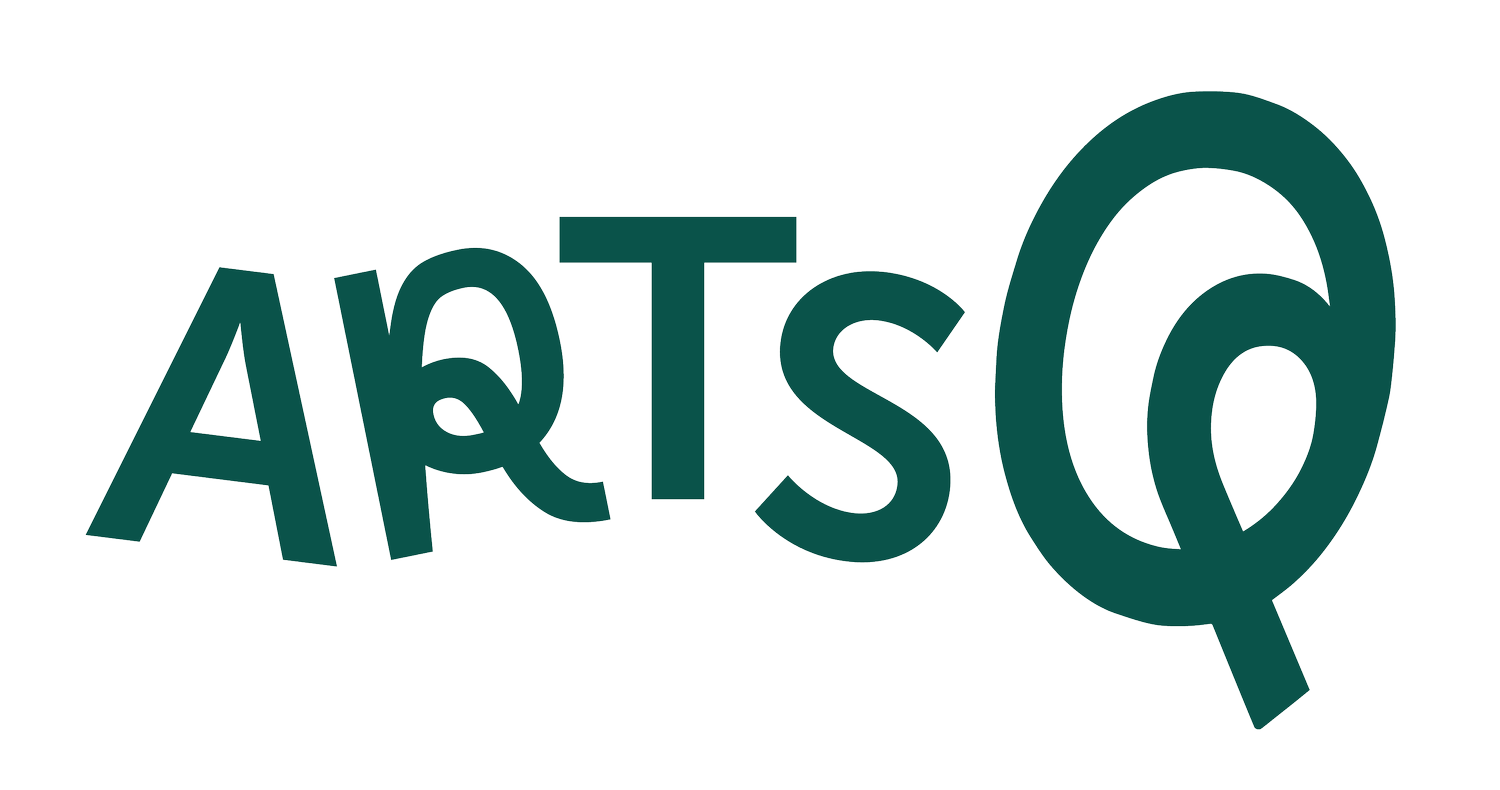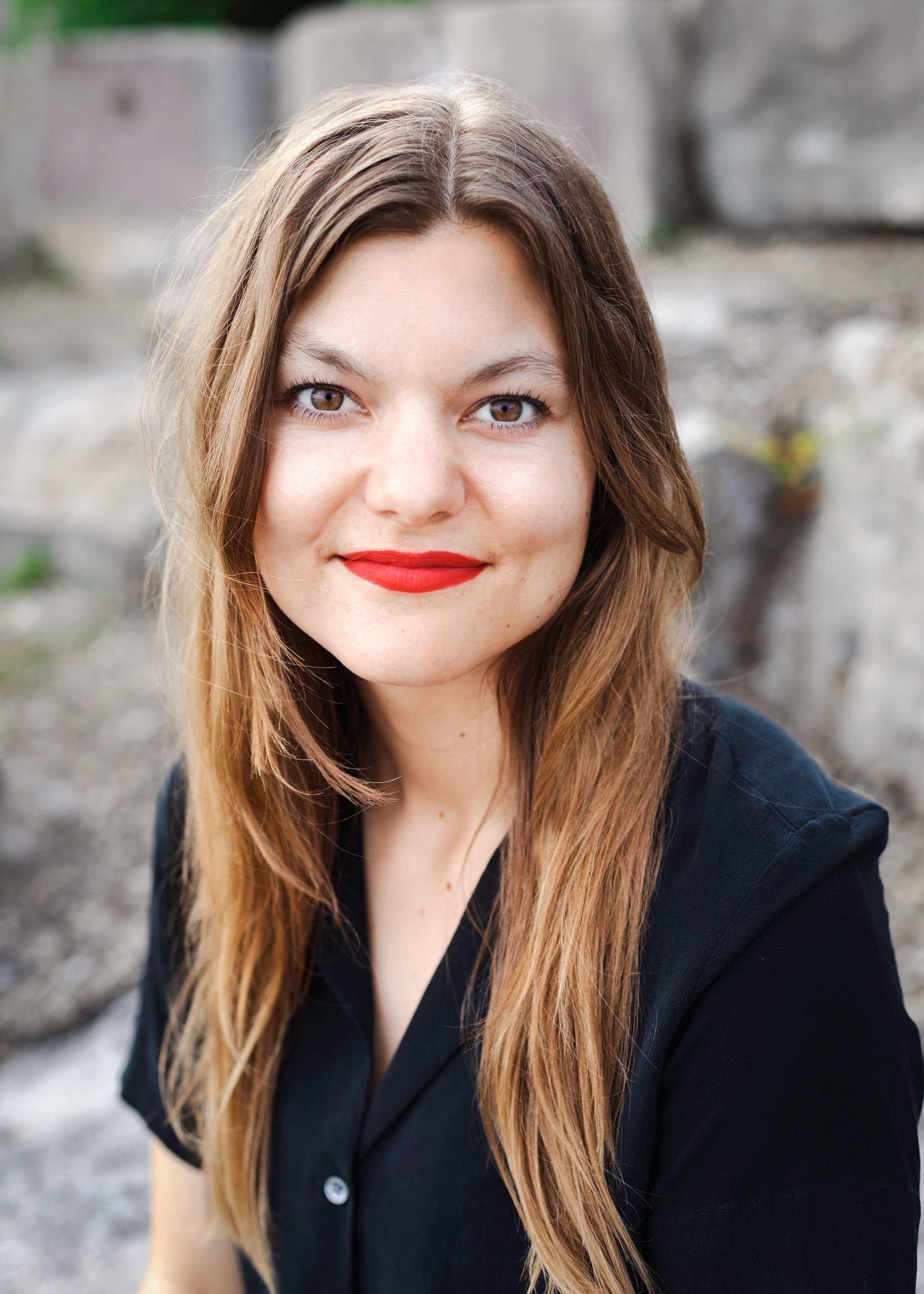Meet ARTSQ cofounder Ellen!
*Ellen Larson was an original co-founder of ARTSQ in 2023, but has since moved on to another position.
Q: Introduce yourself!
Hi! I am Ellen, an ARTSQ co-founder. I am currently based in Chicago, Illinois, where I work as a curator, designer, and educator. I have a PhD in contemporary Chinese art history from the University of Pittsburgh and a master’s degree in modern Chinese history from Minzu University of China. Between 2012 and 2016 I lived and studied in Beijing, China. I worked at a contemporary art gallery, which influenced my interests in contemporary art curating and writing.
I also have my own graphic design practice and do freelance design work related to branding and identity, along with certain aspects of product and package design.
When I am not writing about art, teaching, or designing, I enjoy hanging out with my dog Lola, singing karaoke, plunging into Lake Michigan, and watching films.
Q: Was art a part of your life growing up?
How did you get into the field of art history
(what is art history anyway?!)?
Growing up in a small town in central Wisconsin (population 500 people, if you can believe it?!), I didn’t have many opportunities to visit art museums as a kid. But now, looking back, I realize that I actually come from a family of artists, makers, tinkerers, and designers! My dad was a carpenter who was always involved in various woodworking and construction projects. I definitely inherited his meticulousness and attention to detail, just not his measuring skills. My aunt is an artist and retired high school art teacher. She bought me my first sketchbook and used me as her “guinea pig” to test out various art projects for her classes. My earliest memories of my grandma involve her in the midst of various processes of making, mending, fashioning, and crafting. One of her finest artistic creations included a one-acre garden, which provided the raw materials to fill her basement pantry full of canned tomatoes, beans, pickles, and squash, along with most dinners my brothers and I ate as kids. My grandpa was a fixer, a problem solver, and inventor. He could often be found puttering in the garage or stationed beneath a tractor, lawnmower, or ATV, troubleshooting an engine or valve issue. My grandpa was a creative and imaginative man. He was an animated storyteller and won numerous awards and accolades at local fairs and Independence Day Parades for one of his finest “inventions,” a self-propelled manure spreader. 😉
I loved drawing as a kid and towed around a pencil and sketchpad almost everywhere I went. Art class was my favorite subject in school, especially because my art teacher would often spend time introducing our class to artworks made by famous modern and contemporary artists. Thanks to my art teacher, I fell in love with works made by some of my greatest artistic inspirations to this day—artists like Frida Kahlo, Louise Bourgeois, Louise Nevelson, July Chicago, Janet Fish, and others. These lessons make up some of my most vivid school-age memories.
In college, I discovered that it was possible to enroll in courses dedicated to the study of art made across time and cultures. Upon making this realization, I was lucky enough to major in art history. It wasn’t long after this that I walked into my first Arts of Asia course, which changed the trajectory of not only my studies, but also my life. I discovered Chinese art, and the rest was… well, history! 🙃
Q: What do you do at ARTSQ?
What do you like most about your role?
At ARTSQ, I am responsible for design and branding. My favorite project so far has been designing the official ARTSQ logo!
One of the things I like most about my role at ARTSQ is the opportunity to collaborate with likeminded people who prioritize generosity and empathy as much as they do content creation. I am also really excited about all the opportunities to try new things and learn new skills. This has included website development (and even a little coding! ), animation, and video production work, I am always looking to expand my graphic design experience and recently got to collaborate with fellow ARTSQ co-founder Dr. Cortney Chaffin Kim on a reader about the amazing Shang Dynasty ruler Fu Hao. This book will be the first in a series of books published by ARTSQ. This project was my first crack at book illustration and cover design (Anyone need a book cover? My DMs are open)!
Q: What are your favorite works of art?
This is like asking me to choose my favorite dog!
I have many favorite works of art, including video works by artists like Cao Fei, Chen Qiulin, Samson Young, Isaac Julien, and Tao Hui. I also love drawings and paintings made by Etel Adnan, Lorna Simpson, Sol Lewitt, Alex Katz, Paul Cezanne, Hilma af Klint, Yu Hong, and others; sculptures and installations by Haegue Yang, Ruth Asawa, Louise Bourgeois, Eva Hesse, Baseerah Khan, and Himali Singh Soin; and photographs by individuals like Nan Goldin, Zoe Leonard, Ana Mendieta, Pixy Liao, Rong Rong, Xing Danwen, and others. The list goes on and on…
Of late, I have been thinking a lot about the artist Félix González-Torres. One of my favorite works made by González-Torres is titled Untitled (Perfect Lovers) from 1991. Untitled features two identical commercial clocks installed on a gallery wall right next to one another. According to the artist’s specifications, the clocks must be synchronized to the exact same time, even though they may gradually fall out of sync over the course of several weeks or months. If one or both clocks cease functioning, they are removed, repaired, then reinstalled and reset to the same time. While deceivingly simple, this work makes me think about love, loss, grief, and memory. Untitled (Perfect Lovers) is especially poignant as González-Torres made the work around the time his partner of eight years, Ross Laycock, died of complications from AIDS. In some ways, Untitled (Perfect Lovers) reminds me of a memento mori painting. If that’s a new term for you, memento mori is an artwork designed to remind viewers of both the fragility of life, along with one’s own inevitable mortality.
Another work I have been recently drawn to is an installation by the artist Song Dong titled Waste Not. This work displays over 10,000 household items that once belonged to the artist’s late mother. Each object is meticulously presented over a large installation space. According to the artist, his mother was adamant about preserving and repurposing rather than discarding anything. She belonged to a generation that suffered great socio-political upheavals during much of the 20th century in China. These conditions had a profound impact on her hoarding habits and behaviors later in life. The ways in which Song Dong’s work asks us to think about memory, loss, impermanence, and the transience of human behaviors makes me think a lot about my own grandparents’ lives, and therefore offers a deeper, more personal connection to Song Dong’s artistic practice.
Q: Where is your favorite place to look at art?
I visit art museums every chance I get. Living in Chicago, I love visiting the Art Institute of Chicago, Museum of Contemporary Art, and UChicago’s Smart Museum of Art.
One of the most memorable viewing experiences occurred during my visit to the Teshima Art Museum, located on a small island in southern Japan called Teshima Island. Surrounded by rural rice terraces, Teshima Art Museum is the result of a collaboration between artist Rei Naito and architect Ryue Nishizawa.
The building's structure is a simple empty concrete shell. Its shape suggests an egg or even a water droplet at the exact moment it hits the ground. Two ovular openings are cut into the ceiling, allowing all natural elements to enter the empty space. Within the museum, water perpetually springs from the ground, creating a dynamic, day-long spectacle. I laid on the ground for an extended period of time, captivated by the ways in which water droplets moved across the floor. I left only after watching the sun move across the entire expanse of the space’s cool concrete floor.
Q: Do you have advice for people who want to learn more about art but don’t know where to start?
When I was a kid, I spent a lot of time at the public library. There, I discovered loads of books about everything from the life of Vincent van Gogh, the history of Italian renaissance painting, and architecture books, to manuals detailing how to draw horses and dogs. The great thing about spending time in a library is the opportunity to browse through the stacks! I often discover books I would have never encountered otherwise! When I was in elementary school, I also loved visiting my school’s library and received recommendations from my school librarian, after she learned I was interested in art. Make your interests known! Librarians LOVE to help!
I strongly believe that anyone can be an artist if they want to! If you or someone you know wants to learn more about how to make art, I suggest that you just start doing it! You don’t need to spend a lot of money on fancy art supplies and if you look hard enough, you will discover that you may have more “art supplies” lying around than you realize. When I was a kid, I made drawings with charcoal found in my family’s outdoor fire pit. I also created soap carvings out of inexpensive bar soap, modeled papier mache animals from old newspaper, and Elmer’s glue, and pressed flowers and leaves in books before assembling them together as colorful natural collages.
I think one of the most important skills I possess, as someone who has dedicated much of their life to the study of art, is the ability to look. If you want to become more comfortable looking at art, start by simply looking. Afterwards, you might ask yourself questions about what you see. How does it make you feel? What do you like about it? Is there anything you dislike? You might surprise yourself with how much you can learn about a work of art by simply taking the time to look! 👀
Q: Ok, just for fun—what is your superpower? 🦸🏼
My superpower is definitely my passion. I possess a strong and intense enthusiasm for things that deeply resonate with me—from the big things such as social justice causes and issues related to race, class, and gender, to the small stuff like evening walks with my dog or an excellent cup of coffee. Since I was young, passion has always pushed me to pursue my goals with a strong sense of determination and resilience.
My passion has helped me overcome obstacles and setbacks in my life and has led me to fulfilling relationships and collaborations. Much like an invisible car or roadmap, passion offers me direction and moves me as I pursue both personal and professional aspirations that offer me deep both purpose and peace.











